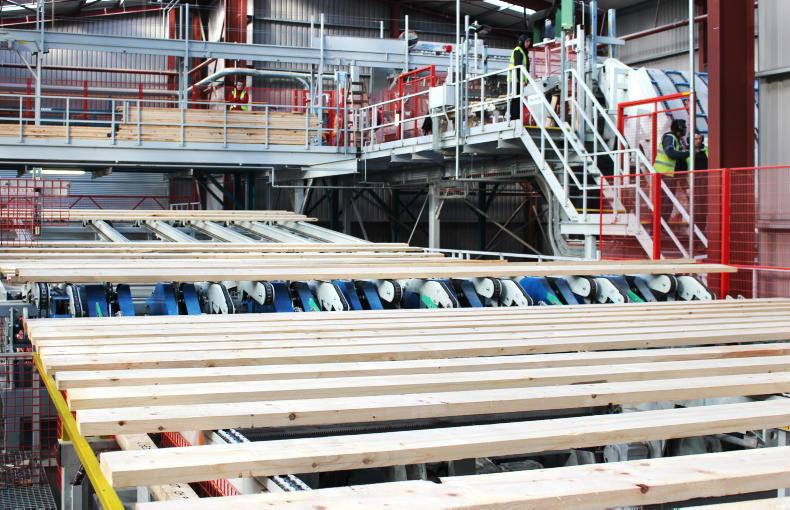The performance of Irish timber processors since the economic crash has been remarkable considering the collapse of the construction industry, the sector’s main market. Despite the crash and recent uncertainty due to Brexit, all of the 11 main sawmills and wood-based panel mills are not only still in business but have managed to increase export market share.
According to the 2017 Irish Forestry and Forest Products Association (IFFPA) overview, the forest products sector exports 75% of its production output, mainly to the UK.
While Brexit has had a significant impact on the forest industry during the aftermath of the vote to leave in June 2016, markets and prices have recovered. Sawmills and board mills have adapted to the immediate fall in exchange rates when the value of the pound dropped sharply from €1.30 to €1.10 within a few months before reaching a low of €1.08 last August. While sterling is now back to €1.14, it is well below pre-Bexit rates, not to mention the €1.73 achieved in 2000.
UK
Despite this, timber processors have managed to hold and marginally increase prices. However, log prices are also historically high in the UK, forcing some mills to cut production, while one Scottish mill – Callander and Son – has gone into administration.
Log prices in the UK have been increasing steadily since 2015.
“The average price for softwood sawlog sales was £43.23/m3 (€49.71) in nominal terms in the six-month period to March 2017, an increase from £39.00 (€46.80) in the six months to September 2016 and £36.52 (€49.30) in the six months to March 2016,” according to the Forestry Commission (FC) report Timber Price Indices – Data to March 2017. Sterling fluctuated widely during these periods – from 71 to 91 pence per euro. (I have used average conversions for respective periods quoted in the FC report.)
Closing the gap
So, while average sterling sawlog prices increased by 35% from October 2015 to March 2017, the euro price remained virtually the same when exchange rates are factored in. Regardless of the currency differential, log prices in the UK are slowly closing the gap on Irish prices.
The huge differential between Irish and UK prices is long gone. For example, the average price paid for category 0.475-0.499m3 standing timber in Britain from April 2014 to March 2015 according to FC data at the time was €24.66/m3, little more than half of Irish prices when a strong pound converted to an average price of £17.45/m3 at the time.
Now, UK sawlog prices are heading close to the €50/m3 mark, not far behind sawlog prices of €55.00/m3 achieved by Coillte in 2017 and the upward trend is likely to continue.
“Whereas £40 per tonne standing used to benchmark price...for a spruce clearfell, it looks like in 2018, £50/t will become the new £40,” according to Oliver Combe in the February issue of Confor’s Forestry & Timber News.
Markets
While Irish boardmills have limited opportunities to increase European and global market share in the future, the UK is likely to remain the sole market for Irish sawmills in the foreseeable future and this is a major concern for the Irish forestry and forest products sector.
Bord Bia recently outlined the risks to the Irish food and drinks industry due to its reliance on the UK market which accounts for 35% of its export market. Close to 100% of sawmill exports go the UK, while 66% of panel products are sold in the UK and Northern Ireland, according to IFFPA.
While the panel board industry has greater opportunities for export market diversification, sawmills will find it difficult to reach new markets. Diversifying within the EU26 will require increased co-operation between the sawmills, Enterprise Ireland and Coillte.
Global markets
Timber exporters in other European countries have been exploring international markets in recent years and despite threats of tariffs from the Trump regime, some of these have targeted the US. For example, a number of EU countries – mainly Sweden, Germany, Finland and Austria – increased exports by 340% to the US in the month of January this year compared with January 2017, according to Timber-online.net.
This represents an increase from $15m to $66m in one month’s softwood trade. This may not appear as huge international trade but is impressive when compared with total Russian and Chinese softwood exports to the US in January, which amounted to only $5.8m, while Canadian exports fell by $79m to $394m for January.
For the moment, Irish sawmills are sitting tight as they have one major advantage over other exporters even if a hard Brexit results in World Trade Organisation (WTO) intervention. Sawn softwood currently attracts a zero tariff under existing WTO rules. However, wood-based panel products would attract a tariff of 7% if WTO rules were to apply. This is not an insurmountable levy but coupled with currency fluctuations it would present a major challenge to an industry, already with extremely tight margins.






 This is a subscriber-only article
This is a subscriber-only article










SHARING OPTIONS: